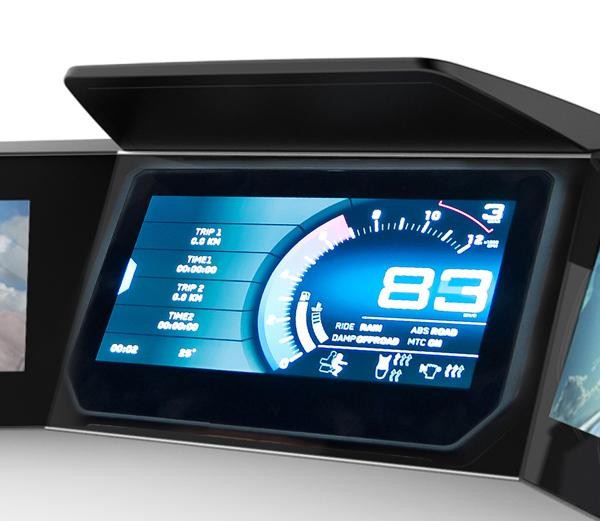The prosperity of new energy, self-driving car and IoV (Internet of Vehicles) drives the growth of automotive display which becomes the 3rd major display application.
Research indicates the growth could be double-digit level. The automotive display shipment will reach 170 million pieces in 2018, a 13% increase from 2017, and the product standard is also greatly enhanced. An IHS Market statistic shows that Innolux was the first runner-up in the automotive display last year, just after JDI. TJ Lin, GM of AII Product stated that the benefit of Innolux with tier 1 automotive brand is becoming obvious and a leap of shipment is expected during 2018-2021.
29” Automotive Integrated Curved Display For One Stop Shipping
The popularity of autonomous car is increasing in the new 5G era. The development of automotive display approaches large-size, curve and free form. Innolux offers total solutions for customers to include integration design, backlight module, panel, lamination, and large-size curved cover glass. The 29” large-size integrated curved display combines cluster and CID embedded a S shaped laminated safety glass (LSG) with minimum curvature of R 60mm. Other than multiple displays, the development of one piece large-size free form lamination technology is going to complete in near future. It adopts LSG surface treatment and decoration to merge dashboard design.

Innolux Automotive Display Booth Themes: Image- Interaction- Integration
Innolux is focused on automotive display and represent technology by 4?och1?och for customers: image, interaction, integration and industrialization. Innolux will exhibit three themes: enhancement of image and panel product appearance, huaman-machine interaction, and technology integration of components at Touch Taiwan Exhibition.
Image: As for the enhancement of image and panel product appearance, Innolux presents GO BLACK technology to level the color difference between display and cover glass printing area for the pursuit of style of automotive dashboard.
Interaction: With continuous vibrated automotive environment, repetitive of false pressing of touch screen may happen. People may be distracted and affect driving safety. The need of alternative way of touch control and verification are considered. Innolux releases the hovering touch and haptic feedback technology which enables touch control without direct contact and verification by vibration feedback to prevent accident and to enhance the user experience and interaction between drivers and vehicles.
Integration: A 11.6 och narrow border (3mm) automotive display is presented to for the pursuit of stylist outlook and wide visual range on panel products. Another 6.5?och heavy motorcycle display enhanced display on heavy vibration environment and visibility under sunlight is also showcased and adopted by customer.
Innolux unveiled (Active Matrix) AM miniLED driven by TFT last June and was granted PixinLED patent. Chin-Lung Ting, Executive Vice President, led Innolux team to exhibit the world’s first 10.1”AM miniLED automotive display in 2018 CES. The product was widely recognized and expected by tier 1 vehicle brands to replace OLED.
Innolux showcases in Touch Taiwan 2018 three major technologies: 65” 8K + miniLED, 10.1” Curve Hi-CG% miniLED, and PID-LED.
- 65” 8K + miniLED features high color saturation (>94% BT2020 cover ratio, 125% NTSC), high contrast
ratio (1,000,000 : 1), low color shift and wide viewing angle, and low color shift and blue light filter. - 10.1” Curve Hi-CG% miniLED features sophisticated local dimming (6720 zones), HCG (95% NTSC) and
high curve radius display (R400). - PID-LED features ultra-thin LED interval 1.2mm (P1.2), borderless LED display wall, HCG 113% NTSC and
high contrast ratio.
The PID-LED showcased in June was expected to be mass produced in Q4. The 65 inch large size TV will be available in Q2 2019. Other product series are upcoming. Automotive product is estimated to be available in 2020 as the certification process takes time.

